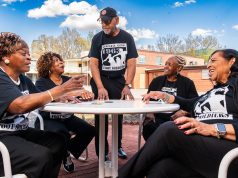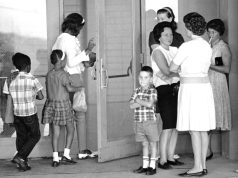By Coretta Collins
Traditional, virtual, remote, blended, are like buzz words flooding our timelines, inboxes, thoughts and conversations. As school systems are trying their best to prepare for back to school, so much is being considered and it seems that school systems, teachers and parents are in a tailspin. Maybe a little perspective will help parents in their decisions.
If we are strictly talking about safety, then in your heart and mind you know that the virtual (also known as remote) schooling option is the safest which means to be protected from or not exposed to danger or risk; not likely to be harmed. So in terms of what is safest, it should not be a surprise to anyone that when it comes to the COVID-19 pandemic that the safest option for children is being home and being home means choosing the virtual platform for education.
Each family has to determine what is best for them. The virtual format may not be feasible for everyone. The format comes with challenges despite the fact that it is the safest option. Though it is the safest many parents must work outside of the home to support their families, not all parents who work from home can truly “work” and become the virtual school facilitator/teacher for their children, not all parents have the proper tools, training, wherewithal and if I may be completely honest, the patience and desire to meet the particular needs of their children virtually.
The impact can be even greater in families who have more than one child. There are also many parents who may not have outside support to help with what could be considered homeschooling. Some parents are not able to afford tutors or nannies who could help them either. Some don’t have family members or friends who are able to fill in the gap for them.
Depending on your life’s circumstances the “safest” approach may not be the best approach for you. In this case, you do your best to make your option, the safest for you. It is also important to remind ourselves that for the most part, our teachers and school systems have the best interest of the students in mind.
In my case, the option that works best for my family is the traditional option. I have three children, ages 9, 7 and almost 4. As a nurse practitioner, I am not able to work from home and even if I was, I’m sure my work and their schooling would be impacted. Additionally, my husband’s career is within the school system. Therefore, we’ll have to do our best to make the traditional option as safe as possible for our kids.
Here are 10 things I am doing to prepare my children to return to school in the traditional format.
- Mask training.
If your children are like mine, they haven’t been in public much since March so they are not accustomed to wearing a mask for hours a day. Gradually start getting your child accustomed to wearing a mask by starting with short periods of time at home and increase the time each day. For example, we’ll start with 10 minutes and increase to 15 minutes and so forth. Encourage your child not to touch the mask which is very hard for children. Be sure the mask is a proper fit for your child. This will help deter some of the touching. Consider using a lanyard to keep your child from losing the mask and to keep it from falling on the floor when eating or drinking. The lanyard will connect to one of the ear loops of the mask. The main key to wearing a mask is to be sure you are wearing it properly. The mask must cover the nose and the mouth entirely otherwise it is defeating the purpose.
- Keep hand sanitizer handy. Encourage your children to sanitize often. Encourage them to be more aware of the things they touch and do. I plan to use a sanitizer holder and attach it to the pants loops of my children’s pants or backpack.
- Pack lunch and snacks.
Likely the school systems are preparing for some type of “no contact” lunch but another option is to just pack your child’s lunch and a snack if feasible. This further decreases the likelihood of contamination. Remind your children that they are not to share food with anyone and that no one can share food with them. Be sure your child has a refillable water bottle too.
- Sanitize, disinfect, wash and repeat.
Sanitize and disinfect book bags and lunch boxes daily. Also, have children take off clothes upon arrival home for washing. If the child will be inside for the remainder of the day, you could go ahead and have them take their bath. Be sure to keep nails trimmed neatly. Shorter nails are easier to clean and maintain.
- Limit their time at school to school hours as much as you can.
If you are able, try not to allow your child to have too much before school time and after school time. Limiting time at school adds an extra layer of precaution to your safety plan. If your child is riding the bus, be sure they have on their mask and have their sanitizer handy. If your child is going to have to attend after school care, try to pick them up as soon as possible.
- Continue ongoing teaching about the coronavirus.
I make it a priority to teach my children about coronavirus and how it is spread. They need to be aware so that they can help protect themselves. By protecting themselves, they also protect others. Explain it in terms that they will understand. My near four-year-old may not know the ins and outs of the virus but she can tell you to “wear a mask so that you don’t get coronavirus”.
- Trust that your school system and the teachers are going to do their best for your children.
I admit this may not seem like second nature because as parents we feel like no one can take care of our children better than us. However, when you think about it, if you are in the position where you have to send your child to school, it is in your best interest to find some semblance of peace in the midst of this pandemic storm. Make it your business to support your school system and review the details of what the plans are. Do your part by adhering to the plans and encourage other parents that you know to do the same. Initiate open and honest communication with your children’s teachers regarding your concerns. I guarantee that the teacher has the same concerns and want to remain virus-free as much as you want your child to remain virus-free.
- Pray and have faith.
If you are a person of faith, then put your faith in action during this tumultuous time. Pray a prayer of protection and covering for your children, the other children, the teachers and the staff. I’m totally taking God seriously on the pray without ceasing. Do not misinterpret this to mean that because you have faith, you should not use precautions. That is not the case. God gives us wisdom and faith without works is dead.
- Make a contingency plan.
It is possible that even with best practices that traditional school will have to become virtual. It is possible, despite everyone’s best efforts that if the number of cases keep rising that alternative options will be needed. Heaven forbid students or teachers get sick. In case it becomes necessary, prepare to have something in place should the virtual option become the only option.
- Monitor your child for symptoms and conduct daily temperature checks. Checking for fever must become a daily practice. If your child has a fever, make alternative plans for the child to stay home. This is not the time to minimize any symptoms that your child may have. If everyone would be prudent in symptom monitoring, it could prevent others from getting sick, faculty and staff included thus allowing the traditional option to continue. Early intervention is key. If something is going on with your child, do not hesitate to contact your health care provider.
For those who really want to opt for the virtual option but have many of the constraints noted above here is something else to consider. Pool with other parents who also want this option to share responsibility and care. Two or three families could potentially work together to make the virtual option work for them. Creativity is a must during these times to accomplish your goals.
Coretta Collins is a board certified family nurse practitioner, writer and speaker. She currently serves patients with cancer and blood diseases at Hematology & Oncology Associates of Alabama. Additionally, she promotes health education through her blog, Confessions of a Nurse Practitioner. For more visit www.ccthenp.com.
Click one of the links below to read more back to school stories.
BCS Parent Tyrone Silmon on How Remote Learning Will Affect His 10 y.o.
Lotoria King Has 3 Children in BCS. Her Plans for Their Virtual Classes





